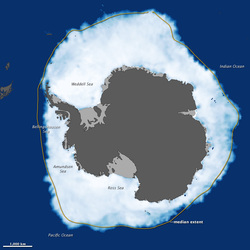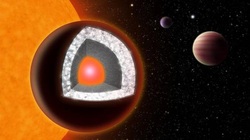
504240
665179
Antarctic Sea Ice Reaches Record High Levels
The sea ice circling Antarctica reached record levels late last month, extending 7.51 million square miles (19.44 million square kilometers), the most ever recorded by satellite.
The previous record was set in 2006, at 7.49 million square miles (19.39 million km), according to the National Snow and Ice Data Center (NSIDC).
On Sept. 26, microwave images flown as part of the Defense Meteorological Satellite Program captured the maximum sea ice extent. Dark gray land fills the center of the image, and light gray ice shelves float just offshore. (Ice shelves are the tongues of land-bound glaciers that extend out into the sea.) The yellow outline circling Antarctica defines the median sea extent from 1979 to 2000 — the total area in which the ice concentration in the ocean was at least 15 percent.
The record ice pack is likely due to stronger winds caused by warming temperatures in the Antarctic, according to a NASA statement. These circumpolar winds generally act to blow sea ice outward, except in the Antarctic Peninsula region, where winds from the north push the ice southward. Thus, sea ice extent near the northwestern Antarctic Peninsula declines rapidly, while areas in the Ross Sea and the southern Indian Ocean show significant increases, according to NASA.
Just as the Antarctic reached its zenith, the Arctic ice pack shrank to its minimum extent for the year– and it was a record low. The minimum was set on Sept. 16, at 1.39 million square miles (3.61 million square km). That is almost 300,000 square miles (777,000 square km) less than the previous record minimum set in September 2007 (1.61 million square miles or 4.17 million square km).
http://www.livescience.com/23912-antarctica-sea-ice-record-image.html
665179
Antarctic Sea Ice Reaches Record High Levels
The sea ice circling Antarctica reached record levels late last month, extending 7.51 million square miles (19.44 million square kilometers), the most ever recorded by satellite.
The previous record was set in 2006, at 7.49 million square miles (19.39 million km), according to the National Snow and Ice Data Center (NSIDC).
On Sept. 26, microwave images flown as part of the Defense Meteorological Satellite Program captured the maximum sea ice extent. Dark gray land fills the center of the image, and light gray ice shelves float just offshore. (Ice shelves are the tongues of land-bound glaciers that extend out into the sea.) The yellow outline circling Antarctica defines the median sea extent from 1979 to 2000 — the total area in which the ice concentration in the ocean was at least 15 percent.
The record ice pack is likely due to stronger winds caused by warming temperatures in the Antarctic, according to a NASA statement. These circumpolar winds generally act to blow sea ice outward, except in the Antarctic Peninsula region, where winds from the north push the ice southward. Thus, sea ice extent near the northwestern Antarctic Peninsula declines rapidly, while areas in the Ross Sea and the southern Indian Ocean show significant increases, according to NASA.
Just as the Antarctic reached its zenith, the Arctic ice pack shrank to its minimum extent for the year– and it was a record low. The minimum was set on Sept. 16, at 1.39 million square miles (3.61 million square km). That is almost 300,000 square miles (777,000 square km) less than the previous record minimum set in September 2007 (1.61 million square miles or 4.17 million square km).
http://www.livescience.com/23912-antarctica-sea-ice-record-image.html

We make Arctic melt
Record melting of Arctic ice has alarmed climate scientists, but the extraction industry and shippers are thrilled at new business prospects.Having drained the world of most accessible oil, companies see in the Arctic Circle a most striking source for long-term fossil-fuel development. Shipping companies plan direct routes to Asia. It’s high time governments wake up to real danger.
A recent UN report projects Arctic summer ice to be non-existent by 2020. Climate researchers warn that the rapidly melting ice, with darker ocean waters that absorb the sun’s heat, will contribute to a shifting jet stream, creating new and unpredictable volatile weather patterns.
International oil companies acknowledge the melting is an effect of global warming. Yet instead of being alarmed, countries such as the US, Norway, Russia and even China are using the melting as a pretext for strategic benefit from global warming to gain new fossil fuel supplies. Global-warming skeptics, free-market adamants, major companies and governments have quickly come to accept future climate change as a new normal. Few deny that climate change is underway. Whether governments and humans can take steps to stem their addiction and help the planet recover is the real issue.
In his 2006 environmental documentary, ‘An Inconvenient Truth’, former US vice-president Al Gore shows a scale. On one side is the earth, the other side, a sum of gold bricks. He presumes the world’s long-term health is considerably heavier than the pile of gold bricks of economic interests and that world governments would take concerted action to stop it. He was wrong. Most countries remain silent to the risks of climate change, and their non-policies continue to ignore it. Short-term economic interests outweigh long-term economic security.
http://www.khaleejtimes.com/kt-article-display-1.asp?section=editorschoice&xfile=/data/editorschoice/2012/October/editorschoice_October13.xml
Record melting of Arctic ice has alarmed climate scientists, but the extraction industry and shippers are thrilled at new business prospects.Having drained the world of most accessible oil, companies see in the Arctic Circle a most striking source for long-term fossil-fuel development. Shipping companies plan direct routes to Asia. It’s high time governments wake up to real danger.
A recent UN report projects Arctic summer ice to be non-existent by 2020. Climate researchers warn that the rapidly melting ice, with darker ocean waters that absorb the sun’s heat, will contribute to a shifting jet stream, creating new and unpredictable volatile weather patterns.
International oil companies acknowledge the melting is an effect of global warming. Yet instead of being alarmed, countries such as the US, Norway, Russia and even China are using the melting as a pretext for strategic benefit from global warming to gain new fossil fuel supplies. Global-warming skeptics, free-market adamants, major companies and governments have quickly come to accept future climate change as a new normal. Few deny that climate change is underway. Whether governments and humans can take steps to stem their addiction and help the planet recover is the real issue.
In his 2006 environmental documentary, ‘An Inconvenient Truth’, former US vice-president Al Gore shows a scale. On one side is the earth, the other side, a sum of gold bricks. He presumes the world’s long-term health is considerably heavier than the pile of gold bricks of economic interests and that world governments would take concerted action to stop it. He was wrong. Most countries remain silent to the risks of climate change, and their non-policies continue to ignore it. Short-term economic interests outweigh long-term economic security.
http://www.khaleejtimes.com/kt-article-display-1.asp?section=editorschoice&xfile=/data/editorschoice/2012/October/editorschoice_October13.xml

Diamond planet discovered 40 light years from Earth
New research suggests that a massive, star-scorched planet in the Cancer constellation, not far from our solar system, is made in large part of diamonds, opening new vistas on the way scientists understand how planets are created.
The planet, 55 Cancri e, is twice the size of Earth and so rich in carbon that it holds at least three times our planet’s mass in diamonds, according to a new paper that has been accepted for publication in the journal Astrophysical Journal Letters.
On 55 Cancri e, the surface is covered in graphite, the dark stuff of pencils, with diamonds pushing through from layers underneath, said the paper’s lead researcher, Nikku Madhusudhan, a fellow at Yale University’s Center for Astronomy & Astrophysics.
“We’re talking about a rocky planet. Not much gas, almost entirely solid. The outermost layer is at an extremely high temperature ... There could also be a lot of diamonds on the surface because of the geophysical movements in the interior. The diamonds could come to the surface very easily,” Dr. Madhusudhan said in an interview.
“But just below the surface there is a very thick layer, about a third of the whole radius [of the planet], just in diamonds.”
That rocky, mind-boggling world broils under 2,150C heat because the planet is so close to its star.
“There’s not even a climate left. It’s rubbed off by the heat. It’s a permanent barbecue,” said co-author Olivier Mousis, a French astronomer at Université de Franche-Comté.
The planet is the closest of five that orbit around 55 Cancri A, a star located 40 light years from Earth, close enough that it can sometimes be seen with the naked eye.
http://www.theglobeandmail.com/technology/science/diamond-planet-discovered-40-light-years-from-earth/article4605246/
New research suggests that a massive, star-scorched planet in the Cancer constellation, not far from our solar system, is made in large part of diamonds, opening new vistas on the way scientists understand how planets are created.
The planet, 55 Cancri e, is twice the size of Earth and so rich in carbon that it holds at least three times our planet’s mass in diamonds, according to a new paper that has been accepted for publication in the journal Astrophysical Journal Letters.
On 55 Cancri e, the surface is covered in graphite, the dark stuff of pencils, with diamonds pushing through from layers underneath, said the paper’s lead researcher, Nikku Madhusudhan, a fellow at Yale University’s Center for Astronomy & Astrophysics.
“We’re talking about a rocky planet. Not much gas, almost entirely solid. The outermost layer is at an extremely high temperature ... There could also be a lot of diamonds on the surface because of the geophysical movements in the interior. The diamonds could come to the surface very easily,” Dr. Madhusudhan said in an interview.
“But just below the surface there is a very thick layer, about a third of the whole radius [of the planet], just in diamonds.”
That rocky, mind-boggling world broils under 2,150C heat because the planet is so close to its star.
“There’s not even a climate left. It’s rubbed off by the heat. It’s a permanent barbecue,” said co-author Olivier Mousis, a French astronomer at Université de Franche-Comté.
The planet is the closest of five that orbit around 55 Cancri A, a star located 40 light years from Earth, close enough that it can sometimes be seen with the naked eye.
http://www.theglobeandmail.com/technology/science/diamond-planet-discovered-40-light-years-from-earth/article4605246/
 RSS Feed
RSS Feed